Barr and Stroud Mark II Fire Control Instruments
Barr and Stroud's Mark II series of step-by-step fire control instruments introduced what would remain the classic pattern of design for Barr and Stroud, centered on cyclometric displays on step-by-step circuits.
A notable improvement in thinking was to agglomerate range, deflection and order indications into a combined instruments to simplify wiring and produce a more compact arrangement at both the T.S. and the sightsetters' place at the guns. However, standalone products for single range, single order and single deflection would continue to be produced through Mark III to provide flexibility and in recognition that order information was not needed at every receiver.
Testing
| 1906 Testing between: | Vickers | B & S | F.S.C. |
|---|---|---|---|
| Wires up mast for one group transmitters to one group receivers, any number of guns, including repeat receivers aloft |
17 | 12 | — |
| Number of Orders | — | 8 | 10 |
| Easy to stop at required indication? | Yes | Yes | Not so easy as Vickers |
| Reliability to keep step | Very Good | Very Good | Good |
| Durability in order of merit | 2 | 1 | 3 |
| Ease of repair in order of merit | 2 | 1 | 3 |
| Lowest voltage receivers will work at | 12.5 | 10 | 14 |
| Suitability for placing conveniently for sightsetter | 3 | 2 | 1 |
| Size of combined receiver, inches | 7 x 5.5 x 10 | 10 x 6 x 6.5 | 4.5 x 2.5 x 3 |
| Size of figures | 7/16 inch | 5/16 inch | 5/16 inch |
Mark II instruments were tested by Vernon and Excellent in 1906 in comparative trials with Vickers relay and some very small devices from the Facsimile Syndicate Company. The conclusion was that Barr and Stroud had the best system for heavy guns but could be improved by reducing receiver size for use at Q.F. guns.[1]
It's worth noting that the same source also mentions that Mark II instruments worked satisfactorily at a lower voltage (8.5 volts), at which "each coil of receiver" took 0.14 amperes, and that 5000 yards could be cycled through in 10 seconds (200 steps of 25 yards).[2]
In 1910, Vernon asked Bellerophon to try a modified Mark II Combined Transmitter and a Combined Receiver to see if they were suitable to convey enemy speed and relative course from the TS to the torpedo director position. She reported that the devices worked fine for this purpose, but that the TS was a poor authority on the heading and speed of the target, suggesting a topside position for the transmitter offering better overall visibility than that enjoyed by the Torpedo Control Tower.[3]
Combined Range Deflection and Order Instruments
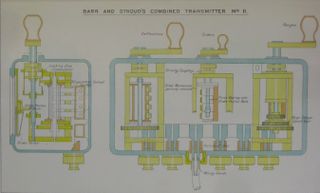

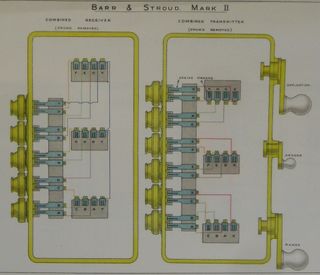
These devices allowed a compact grouping of 3 indications to be jointly expressed from a control to a gun position and are described in the Handbook of Fire Control Instruments, 1914.[7]
todo: photo from range and vision p. 69
The Pattern 80 Combined Transmitter had 3 transmitters, placing deflection at the top, orders in the middle, and range in the bottom position. Each had a handle on the right side of the instrument for setting the desired value. The available orders were displayed in a menu-like list on the front such that all were continually visible, and a pointer moved by the order handle would move it up or down to the order desired. This design helped the operator understand which direction of handle motion would yield motion toward the desired command. A Mark II combined receiver would be placed nearby to indicate the values of all inputs. In this way, the orders were somewhat redundantly indicated.
The order list menu was: SALVO COMM, INDEP COMM, then 6 blank slots, and finally CHECK FIRE, CEASE FIRE.[8][9] I would imagine the 6 blanks in the middle of the list was to permit future additions while in the meantime creating an ample number of steps between those settings which command fire and those which command a cessation of fire. The pointer to indicate the selected command was a pair of fingers which would frame the selected command. This mechanical indicator prevented the order transmitter from rolling cyclically.
The deflection handle was geared so one revolution of the handle registered 1 knot, the order handle needed half a revolution to change to the next order, and the range handle had a clever double-geared design to allow fast or slow changes to be made. Ordinarily, a single revolution of the handle yielded a change of 25 yards, but when the handle was pressed in and spun, this quadrupled to 100 yards per spin.
The provision of the high speed gearing modification for the range data might be a nod to the weakness in step-by-step systems that large changes in reading could take time to apply. It is worth noting that even with this gearing in place, the average synchronization operation where the transmitter was driven to one limit and then the other would take 250 revolutions of the handle!
None of the range and deflection transmitters in the Barr and Stroud family had stops, but the drums in the receivers did. The order transmitter did have a hard stop at each end of the series, owing to the linear nature of the mechanical tell-tale incorporated into the design.
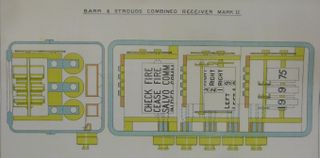
todo: 1909 plate 13 and 14 The positioning of the indicators on the Pattern 78 Combined Receiver (orders at the top, then deflection, then range) does not match those used in the transmitter. This was done to place the range and deflection read-outs in closer proximity to each other to facilitate their quick reference by sightsetters. It was also decided that the orders receiver was not necessary at every location within a gun turret, and so a given turret might have only one complete Combined receiver but up to a total of three range and deflection receivers.[11]
The receiver's rightmost drum for range had 8 positions, with each value (00, 25, 50, 75) occurring twice on opposing sides. The drums, and their readings, were visible through apertures on the front of the case.
Single Range Instruments
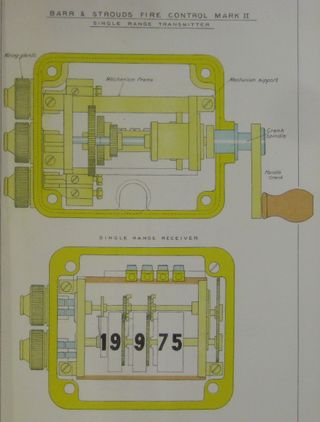
todo: 1909 plate 15 These were used in place of the Mark I instruments originally intended for use with Mark I order instruments and Vickers deflection instruments in 16 battleships as the Royal Navy was first deploying such devices, as well as between the control positions and transmitting stations in some later ships.[13]
The Pattern 2592 Single Range Receiver was the customary Mark II cyclometric design. The Pattern 2593 Single Range Transmitter included a receiver as a tell-tale. It was connected to 5 wires: a charging lead and 3 line wires and return main from the receiver.[14]
Rate Instruments
todo: 1909's 24 and 25 These were primarily used between the control positions and transmitting stations in some ships.[Citation needed]
The Pattern 2594 Rate Receiver was the customary Mark II cyclometric design, and indicated range rates in yards per minute by 10s from 0 to 1990. A shutter indicated "Increasing" or "Decreasing". The Pattern 2595 Rate Transmitter included a receiver as a tell-tale. It was connected to 5 wires: a charging lead and 3 line wires and return main from the receiver.
In 1914, a number of the devices were being updated to Mark II* standards, the primary difference being to move to steps of 25 yards per minute from 10, and to use the terms "opening" and "closing". Orders for this adaptation were issued in 1912, starting with instruments in stock to be thereafter cycled to replace those installed on ships.[17]
Bearing Instruments
There is a weak implication in one source that King Edward VII had two Mark II bearing transmitters and receivers, but it is likely that these were actually Mark II*.[18][19]
Gyro Angle Instruments
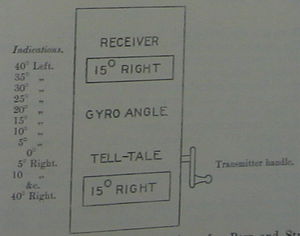
As shown and described in Annual Report of the Torpedo School, 1913.[20]
The Annual Report of the Torpedo School, 1913 describes these newly-created Mark II instruments as meeting the expected arrival of torpedoes whose gyros could be set in 5 degree steps from 40 degrees left to 40 degrees right. These may have been derived from the contemporary versions of the Barr and Stroud deflection instruments. There were two drums and a transmitting handle in the single image provided, but it is not clear exactly how these worked at both ends. Presumably, the control position commanded the gyro angle and saw a tell-tale of its signal and a remotely entered indication of the angle actually applied on the torpedo below.[21][Inference]
See Also
- Barr and Stroud Fire Control Instruments
- Barr and Stroud Mark I Fire Control Instruments
- Barr and Stroud Mark II* Fire Control Instruments
Footnotes
- ↑ Annual Report of the Torpedo School, 1906, p. 84.
- ↑ Annual Report of the Torpedo School, 1906, p. 80.
- ↑ Annual Report of the Torpedo School, 1910, pp. 32-33. (N.S. 016/4824, 2nd April 1910)
- ↑ Handbook of Fire Control Instruments, 1914, Plate 20.
- ↑ Handbook of Fire Control Instruments, 1914, Plate 21.
- ↑ Handbook of Fire Control Instruments, 1914, Plate 22.
- ↑ Handbook of Fire Control Instruments, 1914, p. 24.
- ↑ Handbook of Fire Control Instruments, 1914, Plate 21.
- ↑ Range and Vision, photo on page 69.
- ↑ Handbook of Fire Control Instruments, 1914, Plate 23.
- ↑ Annual Report of the Torpedo School, 1906, pp. 80-81.
- ↑ Handbook of Fire Control Instruments, 1914, Plate 24.
- ↑ Handbook of Fire Control Instruments, 1909, p. 24.
- ↑ Handbook of Fire Control Instruments, 1909, pp. 24-5.
- ↑ Handbook of Fire Control Instruments, 1914, Plate 28.
- ↑ Handbook of Fire Control Instruments, 1914, Plate 29.
- ↑ Annual Report of the Torpedo School, 1912, p. 67.
- ↑ Handbook of Fire Control Instruments, 1909, p. 58.
- ↑ Handbook of Fire Control Instruments, 1914, p. 25.
- ↑ Annual Report of the Torpedo School, 1913, p. 101.
- ↑ Annual Report of the Torpedo School, 1913, p. 101.
Bibliography
- Template:BibUKARTS1906
- Template:BibUKARTS1910
- Template:BibUKARTS1913
- Template:BibUKTorpedoDrillBook1905
- Template:BibUKTorpedoDrillBook1908
- Template:BibUKTorpedoDrillBook1912
- Template:BibUKTorpedoDrillBook1914
- Admiralty, Gunnery Branch (1910). Handbook for Fire Control Instruments, 1909. Copy No. 173 is Ja 345a at Admiralty Library, Portsmouth, United Kingdom.
- Admiralty, Gunnery Branch (1914). Handbook for Fire Control Instruments, 1914. G. 01627/14. C.B. 1030. Copy 1235 at The National Archives. ADM 186/191.

